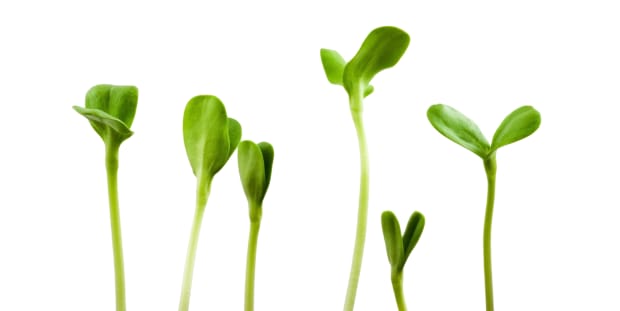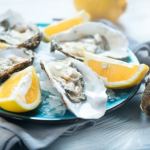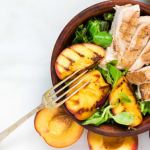- Like
- SHARE
- Digg
- Del
- Tumblr
- VKontakte
- Flattr
- Buffer
- Love This
- Save
- Odnoklassniki
- Meneame
- Blogger
- Amazon
- Yahoo Mail
- Gmail
- AOL
- Newsvine
- HackerNews
- Evernote
- MySpace
- Mail.ru
- Viadeo
- Line
- Comments
- Yummly
- SMS
- Viber
- Telegram
- JOIN
- Skype
- Facebook Messenger
- Kakao
- LiveJournal
- Yammer
- Edgar
- Fintel
- Mix
- Instapaper
- Copy Link
When Organic Avenue co-founder and Juicero CEO Doug Evans started growing sprouts on his countertop 20 years ago while living in the remote California desert, he had no idea that his new life purpose as a sprout advocate was also taking root. As he took control of his diet and started researching this sustainable way of eating, “I began to realize that sprouts could be the answer to personal nutrition and food security for people everywhere,” Evans says.
“Just about every vitamin and nutrient can be found in sprouts. It’s simply a matter of which sprout you eat for higher degrees of certain nutrients,” he says. And even those who’ve long gone plant-based can up their game. “Sprouts contain all of the potent, naturally occurring compounds, antioxidants, and micronutrients that exist within the plants in high concentrations.”
Evans set up a sprouting lab, interviewed experts—“from functional and plant-based medicine MDs to ketogenic and paleo advocates/nutritionists, all of whom agree on the value in sprouting”—and wrote the newly released The Sprout Book: Tap into the Power of the Planet’s Most Nutritious Food. He hopes this intro to sprouting, which includes 40 sprout-centric recipes, opens a conversation about a form of nutrition once considered “on the fringe, hippie food, or used only as a garnish or accessory,” he adds. “My mission is to see sprouts move to the center of the plate or at least become a regular part of our diets.”
Everyone Wants to Know …
BN: What are your top three reasons to eat sprouts?
DE: Sprouts are high-quality plant-based nutrition, they are easy/accessible, and very affordable. They are under a dollar a serving, and there’s even bigger economic leverage when you sprout on your own instead of buying sprouts in the store.
BN: How can sprouting ease food security concerns during uncertain times?
DE: The time to sprout is not for your next New Year’s resolution or summer cleanse, but now, when the question of where your next bag of fresh produce will come from has suddenly become uncertain. Running to the store might not necessarily be the safest option, but if you have a pound of broccoli sprout seeds in your kitchen, you can feed your family fresh veggies for a few months. They are the diamonds that you don’t need to leave your home to find.
BN: Which sprouting method do you recommend for beginners?
DE: The easiest method is unequivocally the sprouting jar. If you already have a mason jar and a piece of cheesecloth, you have all the equipment you need. Online you can buy a mesh screen, either plastic or metal, that screws onto the jar so you can strain them—that is generally the easiest and most successful means of sprouting. You add the seeds and water, soak them between five hours and overnight, then rinse them. In a few days you can harvest and eat them. The most important thing is to make sure that you’re rinsing them and draining them fully at least twice a day. There are many nuances, as every seed is different. My book has a simple overview of the different seeds and how to successfully sprout them.
BN: So that really keeps them as clean as possible to avoid contamination?
DE: Correct. The seeds need water to germinate and they need air. Because the water is still, it can easily become contaminated. I recommend rinsing the seeds several times before you soak them to make sure they are clean. And to make sure they don’t develop mold when you store the sprouts in the fridge, you need to dry them off.
BN: You recommend buying organic seeds. But when should we also look for seeds with a higher germination rate?
DE: A lot of seeds such as lentils and peas may be grown for the purpose of cooking, so if you’re cooking them, the germination may not matter. But if your intention is to sprout them to eat them (raw), a higher germination rate will give you better-quality nutrition and less likelihood of getting mold.
BN: Any tips for buying sprouts in the store?
DE: Part of it is establishing a relationship with your vendors. You want to get the freshest sprouts with the longest shelf life, and you want to develop a rapport to find out the sprouts’ delivery schedule. You can also buy lentils from the bulk bin, soak them overnight, and drain and rinse them. The lentil sprouts are edible after as little as two to three days. Lentils are incredible. But lentil sprouts are incredible plus because the antioxidant in vitamin C increases three times the level when you sprout the lentil. And 1 cup of sprouted lentils has over 7 grams of protein.
BN: Why are broccoli sprouts especially heralded for potential health benefits?
DE: Broccoli sprouts are one of the highest, if not the highest, sources of the compound sulforaphane accessible in a natural form. As of 2019, I counted over 150 scientific papers written about the properties of sulforaphane. The papers covered many health benefits, including extracting the carcinogen benzene from the body, which occurs from exposure to smoking and emissions. And there’s been research that shows that, while there is no cure for autism, broccoli sprouts create a similar effect to heat shock, which may address some of the symptoms of autism. There’s a whole range of research about treating people with autism with broccoli sprouts.
Among cruciferous vegetables, broccoli is on the higher range of sulforaphane content, and broccoli sprouts can have 30 to 100 times the amount of it. When you chew broccoli sprouts or blend them, you break down the cellular walls, and that releases the enzymes that form the sulforaphane. Try to consume 4 to 8 ounces of them every day, whether you’re eating them plain or adding them to a salad or a smoothie.
BN: Which other types of sprouts do you recommend for beginners?
DE: Mung bean sprouts are a powerhouse. One serving size of ¾ cup, which is 6 ounces, contains 3 grams of protein and 18 milligrams of vitamin C. I think that sunflower sprouts—some people call them shoots, others call them microgreens—are incredible because they actually have little green leaves in them. They’re extremely nutritious and delicious, and you can eat them as an alternative to lettuce in a salad.
BN: Which of your book’s sprout recipes are great for summer?
DE: The Lime and Chile Sprouts are great, as they use a seasoning technique common in hot-weather climates. Choose any type of bean or vegetable sprout and sprinkle it with chile powder and salt, squeeze with lime juice, and you have a taste sensation using just four ingredients. The Really Green Salsa with sprouts is also really flavorful. It’s a great way of getting in a lot of herbs and broccoli sprouts, and it has a beautiful color. And the Crunchy Sprout, Celery, and Apple Salad with Golden Tahini Dressing is
an easy salad that’s hearty enough to be a meal.


